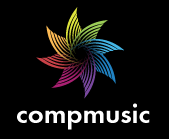DISCOVERING RĀGA MOTIFS BY CHARACTERIZING COMMUNITIES IN NETWORKS OF MELODIC PATTERNS
This is a companion page for:
Article
Gulati, S., Serrà, J., Ishwar, V., & Serra, X. (2016). Discovering raga motifs by characterizing communities in networks of melodic patterns. In Proceedings of the 41st IEEE International Conference on Acoustics, Speech and Signal Processing (ICASSP), pp. 286–290. Shanghai, China.
[Postprint manuscript (PDF@MTG)] [BibTex] [Poster]
Abstract
Rāga motifs are the main building blocks of the melodic structures in Indian art music. Therefore, the discovery and characterization of such motifs is fundamental for the computational analysis of this music. We propose an approach for discovering rāga motifs from audio music collections. First, we extract melodic patterns from a collection of 44 hours of audio comprising 160 recordings belonging to 10 rāgas. Next, we characterize these patterns by performing a network analysis, detecting non-overlapping communities, and exploiting the topological properties of the network to determine a similarity threshold. With that, we select a number of motif candidates that are representative of a rāga, the rāga motifs. For a formal evaluation we perform listening tests with 10 professional musicians. The results indicate that, on an average, the selected melodic phrases correspond to rāga motifs with 85% positive ratings. This opens up the possibilities for many musically-meaningful computational tasks in Indian art music, including human-interpretable rāga recognition, semantic-based music discovery, or pedagogical tools.
Code
The code used for characterizing communities of melodic patterns can be found here.
Dataset
The dataset used for this study can be found here.
Results
We make available the discovered melodic patterns as a network of patterns.


